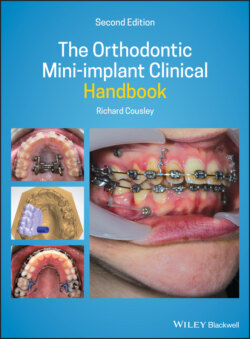Читать книгу The Orthodontic Mini-implant Clinical Handbook - Richard Cousley - Страница 42
3 Maximising Mini‐implant Success: Design Factors 3.1 Mini‐implant Design Factors
ОглавлениеThe endosseous bodies of mini‐implants differ within and between different manufacturers' systems in terms of their:
dimensions – diameter and length
shape – cylindrical or tapered
thread design.
It is reasonable to assume that different design characteristics will influence mini‐implant stability and success rates. In particular, an increase in mini‐implant dimensions (i.e. a larger body) leads to greater contact with the surrounding bone surface area. Crucially, both in vivo and in vitro research projects have demonstrated that diameter is the most important factor in terms of primary stability because an increase in diameter leads to increased insertion torque [1–6].
An increase in body length has a much less pronounced effect (than an increase in diameter) with only a subtle increase in insertion torque and success rates occurring [7,8]. This is because an increase in length provides greater engagement in the cancellous bone, not the cortex, which is concordant with the fundamental influence of cortical bone on mini‐implant stability (as described in Chapter 2). However, increased body length is still likely to be favourable in sites with thin cortical bone (less than 1 mm) where cancellous bone appears to supplement the cortical support. This results in both increased success rates for longer mini‐implants with a longer body [9], and especially in reducing the potential long‐term movement (tilting/migration) of the mini‐implant where the loading force causes excessive peri‐implant bone remodelling but not outright failure [10]. Similarly, relatively large‐diameter mini‐implants are also less likely to be deflected by prolonged loading [11] and, importantly, they are more fracture resistant [12–15].
This begs the question: why are large (e.g. 2 mm) diameter mini‐implants not universally used for increased fracture resistance and stability? The answer is simple: 2 mm diameter mini‐implants are not easily accommodated in alveolar interproximal spaces so most mini‐implants have midbody diameters of around 1.5 mm for these sites. However, 2 mm diameter mini‐implants may be used in edentulous alveolar sites and the midpalate (where, conversely, length is limited by anatomical parameters).
Diameter is the most important factor in terms of primary stability because an increase in diameter leads to increased insertion torque.
The original mini‐implant designs had cylindrical body shapes with self‐tapping threads, and required predrilling of a full‐depth pilot hole. Subsequent designs then favoured tapered (conical) body shapes and these are coincidentally also capable of self‐drilling insertion. Both animal and clinical research studies have shown that the latter is more favourable for primary stability since tapered designs have a higher insertion torque than cylindrical ones, and also a higher removal torque during the bone healing phases [1,2,15–19]. This is because self‐drilling causes less disruption of the peri‐implant bone's original histological architecture and avoids the risk of thermal tissue necrosis (associated with the heat generated by pilot drilling) [6,20–26]. However, predrilling (perforation) of the cortical plate is still valuable in avoiding the generation of excessive torque in thick, dense cortical bone sites, such as in the posterior mandible and midpalate. This is discussed in more detail with regard to insertion technique in Chapter 4.
Finally, the extent of projection of the mini‐implant head into the oral cavity is important since the greater the distance between the position of the loading force and the bone surface, then the higher the risk of an unfavourable force (moment) at the mini‐implant and bone interface [27–32]. Consequently, it is advisable to use a low‐profile mini‐implant design in order to avoid an excessive head and neck length combination relative to the body length, and to fully insert mini‐implants. This is also favourable from the patient's perspective since excessive prominence of a mini‐implant may irritate opposing mucosal and tongue tissues. If the mini‐implant's point of force application does project out from the surface, then lower forces should be used to avoid excessive cortical bone stress [31].
